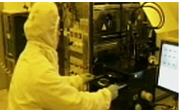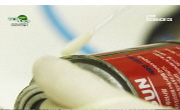현대에 들어오면서 생물학적 분자에 대한 연구가 활발하게 진행되고 있으며 그와 더불어 생물학적 시료의 정량, 정성적인 분석의 중요성도 높아지고 있다. Ru(bpy)_(3)^(2+)를 이용한 전기화학...
http://chineseinput.net/에서 pinyin(병음)방식으로 중국어를 변환할 수 있습니다.
변환된 중국어를 복사하여 사용하시면 됩니다.
- 中文 을 입력하시려면 zhongwen을 입력하시고 space를누르시면됩니다.
- 北京 을 입력하시려면 beijing을 입력하시고 space를 누르시면 됩니다.
Tris (2,2'-bipyridyl) ruthenium (II)를 포함한 졸-겔 실리케이트 막의 전기화학발광 특성 및 응용 = Thin films of polymeric organosilicate gel containing Tris (2,2'-Bipyridyl) ruthenium (II) for the electrogenerated chemiluminescence sensor application
한글로보기부가정보
국문 초록 (Abstract)
본 연구의 목적은 Ru(bpy)_(3)^(2+) 유도체를 ITO(Indium Tin Oxide)전극에 실리케이트 졸 겔 방식으로 고정함으로써 분석물질에 대하여 재현성 있고 안정성 있는 검출법을 제시하고 전기화학발광법을 이용한 DNA 이중결합 검출에의 응용가능성을 알아보았다.
Ru(bpy)_(3)^(2+)의 리간드의 끝에 methoxy silane을 붙이면 이는 실리케이트 졸-겔 반응에 의해 상온에서 고형화 되며 ITO전극과 공유결합을 통하여 붙어 있게 된다. Ru(bpy)_(3)^(2+)사이의 공간을 주기 위하여 PEO(poly ethylene oxide)를 추가로 붙인 막에 대해서도 반응성을 살펴보았다. 전기화학발광을 가장 잘 나타내는 시료로 알려진 Tripropylamine(TPrA)의 정량분석을 통해 다른 방식으로 Ru(bpy)_(3)^(2+)고정한 막들과 성능을 비교하였고 바이오센서의 응용을 위해, pH, 주사속도, ITO 표면처리 방식 등을 변화시키며 전기화학발광의 최적 조건을 찾아내었다. 또한 막의 전기화학발광을 나타내는 시료들의 선택성을 알아보고 안정성에 대한 실험을 실시하였다. DNA 바이오센서로의 응용 가능성을 보기 위하여 이 막 위에 전도성 있는 연결자로서 전도성 고분자의 일종인 3' thiophene acetic acid를 입히고 DNA를 붙인 후, 이중결합 DNA에 끼어 들면서 동시에 전기 화학적인 활성을 가지는 시료들에 대하여 전기화학발광의 정도를 측정하였다.
Ru(bpy)_(3)^(2+)를 포함한 졸-겔 실리케이트 막은 시료의 전하와 상관 없이 고르게 검출이 가능하여 보편적인 전기화학발광 검출 도구로서의 응용이 가능한 것을 확인 하였다. 또한 TPrA에 대한 검출한계가 1.01μM로 뛰어난 성능을 보인다. 막의 안정성도 뛰어나 건조 시킨 상태에서는 반영구적인 보관이 가능하며 제조 후 6개월 이후에도 전기화학발광 특성이 90%이상의 값을 나타낸다. PEO를 첨가한 막은 원래 막보다 검출한계는 떨어지나 전기화학적인 전자전달 반응은 더 잘되는 것을 확인하였다.
DNA 검출 센서로서의 활용 가능성을 알아 보기 위해 이중 결합 DNA 사이에 끼어 들어가면서 전기화학발광적 특성을 나타내는 시료들을 찾고 이에 대한 전기화학발광특성의 상대적 세기를 살펴보면 minocycline이 제일 높고 quinacrine이 그 다음이다. 이 두 가지 시료에 대하여 막위에 고정시킨 DNA에서 전기 화학발광적인 검출이 가능한 것을 확인하였다.
본 연구를 통해서 새로운 졸-겔 방식으로 만든 Ru(bpy)_(3)^(2+)막이 감도와 선택성 안정성면에서 뛰어나며 바이오센서 중에서 특히 DNA 바이오센서로의 응용 가능성이 높음을 밝혀내었다.
현대에 들어오면서 생물학적 분자에 대한 연구가 활발하게 진행되고 있으며 그와 더불어 생물학적 시료의 정량, 정성적인 분석의 중요성도 높아지고 있다. Ru(bpy)_(3)^(2+)를 이용한 전기화학발광 검출은 특히 2차나 3차 아민기를 포함하는 생물학적인 물질에 대하여 선택적이고 감도 높은 검출법으로 근래에 들어서 각광받고 있다. 그러나 전기 화학발광법은 반응 시약을 계속 전극에 공급 해야 하는 한다는 단점이 있다. 따라서 바이오센서에 응용되기 위해서는 Ru(bpy)_(3)^(2+)를 전극에 고정할 필요성이 있다.
본 연구의 목적은 Ru(bpy)_(3)^(2+) 유도체를 ITO(Indium Tin Oxide)전극에 실리케이트 졸 겔 방식으로 고정함으로써 분석물질에 대하여 재현성 있고 안정성 있는 검출법을 제시하고 전기화학발광법을 이용한 DNA 이중결합 검출에의 응용가능성을 알아보았다.
Ru(bpy)_(3)^(2+)의 리간드의 끝에 methoxy silane을 붙이면 이는 실리케이트 졸-겔 반응에 의해 상온에서 고형화 되며 ITO전극과 공유결합을 통하여 붙어 있게 된다. Ru(bpy)_(3)^(2+)사이의 공간을 주기 위하여 PEO(poly ethylene oxide)를 추가로 붙인 막에 대해서도 반응성을 살펴보았다. 전기화학발광을 가장 잘 나타내는 시료로 알려진 Tripropylamine(TPrA)의 정량분석을 통해 다른 방식으로 Ru(bpy)_(3)^(2+)고정한 막들과 성능을 비교하였고 바이오센서의 응용을 위해, pH, 주사속도, ITO 표면처리 방식 등을 변화시키며 전기화학발광의 최적 조건을 찾아내었다. 또한 막의 전기화학발광을 나타내는 시료들의 선택성을 알아보고 안정성에 대한 실험을 실시하였다. DNA 바이오센서로의 응용 가능성을 보기 위하여 이 막 위에 전도성 있는 연결자로서 전도성 고분자의 일종인 3' thiophene acetic acid를 입히고 DNA를 붙인 후, 이중결합 DNA에 끼어 들면서 동시에 전기 화학적인 활성을 가지는 시료들에 대하여 전기화학발광의 정도를 측정하였다.
Ru(bpy)_(3)^(2+)를 포함한 졸-겔 실리케이트 막은 시료의 전하와 상관 없이 고르게 검출이 가능하여 보편적인 전기화학발광 검출 도구로서의 응용이 가능한 것을 확인 하였다. 또한 TPrA에 대한 검출한계가 1.01μM로 뛰어난 성능을 보인다. 막의 안정성도 뛰어나 건조 시킨 상태에서는 반영구적인 보관이 가능하며 제조 후 6개월 이후에도 전기화학발광 특성이 90%이상의 값을 나타낸다. PEO를 첨가한 막은 원래 막보다 검출한계는 떨어지나 전기화학적인 전자전달 반응은 더 잘되는 것을 확인하였다.
DNA 검출 센서로서의 활용 가능성을 알아 보기 위해 이중 결합 DNA 사이에 끼어 들어가면서 전기화학발광적 특성을 나타내는 시료들을 찾고 이에 대한 전기화학발광특성의 상대적 세기를 살펴보면 minocycline이 제일 높고 quinacrine이 그 다음이다. 이 두 가지 시료에 대하여 막위에 고정시킨 DNA에서 전기 화학발광적인 검출이 가능한 것을 확인하였다.
본 연구를 통해서 새로운 졸-겔 방식으로 만든 Ru(bpy)_(3)^(2+)막이 감도와 선택성 안정성면에서 뛰어나며 바이오센서 중에서 특히 DNA 바이오센서로의 응용 가능성이 높음을 밝혀내었다.
다국어 초록 (Multilingual Abstract)
In our experiments, the film exhibits a good sensitivity and selectivity. The film gives a linear response for TPrA concentration over approximately three orders with a limit of detection of 1.01 μM. Thin film can detect efficiently both charged and neutral analytes. So it can be used as an universal detector due to its selectivity One of the merits of this film is a good stability. Once made electrode can be stored in room temperature more than six months with only 10 % reduction of ECL intensities. We have also produced more hydrophilic films added poly ethylene oxide. This film has a good selectivity for large molecule.
DNA ECL sensor has been constructed based on the double layer format consisting of Ru(bpy)_(3)^(2+) modified sol-gel film and electropolymerized poly(3-thiophene acetic acid). Carboxyl group of conducting polymer covalently attaches amino groups of the probe double strand DNA using EDC. After intercalation by Quinacrine, ECL intensities enhanced 30%. We can find possibility of DNA sensor application using ECL.
Electrogenerated chemiluminescence detection has been proven to be a powerful analytical tool that combines the inherent sensitivity, selectivity, and wide linear range for amine containing analytes. Despite of several advantages of ECL reaction, its ...
Electrogenerated chemiluminescence detection has been proven to be a powerful analytical tool that combines the inherent sensitivity, selectivity, and wide linear range for amine containing analytes. Despite of several advantages of ECL reaction, its widespread application is limited by the requirement to continuously deliver the chemiluminescence (CL) reagent of catalyst into the reaction cell because the CL reagent is consumed. The limitation can be overcome by immobilizing the Ru(bpy)_(3)^(2+) reagent in immobilized of solid-state formats. Therefore, in this study, we developed new methods of Ru(bpy)_(3)^(2+) immobilization based on organosilicate sol-gel containing Ru(bpy)_(3)^(2+) attached covalently to an ITO electrode.
In our experiments, the film exhibits a good sensitivity and selectivity. The film gives a linear response for TPrA concentration over approximately three orders with a limit of detection of 1.01 μM. Thin film can detect efficiently both charged and neutral analytes. So it can be used as an universal detector due to its selectivity One of the merits of this film is a good stability. Once made electrode can be stored in room temperature more than six months with only 10 % reduction of ECL intensities. We have also produced more hydrophilic films added poly ethylene oxide. This film has a good selectivity for large molecule.
DNA ECL sensor has been constructed based on the double layer format consisting of Ru(bpy)_(3)^(2+) modified sol-gel film and electropolymerized poly(3-thiophene acetic acid). Carboxyl group of conducting polymer covalently attaches amino groups of the probe double strand DNA using EDC. After intercalation by Quinacrine, ECL intensities enhanced 30%. We can find possibility of DNA sensor application using ECL.
목차 (Table of Contents)
- 차례 = i
- List of Figures = iv
- List of Tables = vii
- 국문요약 = viii
- 제1장 서론 = 1
- 차례 = i
- List of Figures = iv
- List of Tables = vii
- 국문요약 = viii
- 제1장 서론 = 1
- 제2장 이론 = 4
- 제1절 전기화학발광법 = 4
- 1.1. Ru(bpy)_(3)^(2+)의 전기화학발광법 = 4
- 1.2. 계면활성제가 전기화학발광에 미치는 영향 = 7
- 1.3. 전극 표면의 Ru(bpy)_(3)^(2+)의 고정화 = 9
- 제2절 DNA 검출 = 12
- 2.1. DNA 검출방법 = 12
- 2.2. 전기화학발광법을 이용한 DNA 검출방법 = 17
- 제3절 기기와 원리 = 20
- 3.1. ITO 전극 = 20
- 3.2. SEM의 원리 = 21
- 3.3. 순환전압전류법 = 23
- 제3장 실험 = 25
- 제1절 계면활성제가 Ru(phen)_(3)^(2+)의 전기화학발광에 미치는 영향 = 25
- 1.1 SDS(sodium dodecyl sulfate)가 Ru(phen)_(3)^(2+) 전기화학발광에 미치는 영향 = 25
- 제2절 Ru(bpy)_(3)^(2+) 고정화 막의 전기화학발광적 특성 고찰 = 26
- 2.1 Ru(bpy)_(3)^(2+) 고정화 막의 제작 = 26
- 2.2. ITO 전극의 표면처리 = 29
- 2.3. Ru(bpy)_(3)^(2+) 고정화 막의 전기화학적 특성 = 30
- 2.4. Ru(bpy)_(3)^(2+) 고정화 막의 전기화학발광적 특성 = 30
- 2.5. 최적 조건의 결정 = 32
- 2.6. Ru(bpy)_(3)^(2+) 고정화 막의 표면 분석 = 32
- 2.7. Ru(bpy)_(3)^(2+) 고정화 막에서 TPrA의 결정 = 32
- 2.8. Ru(bpy)_(3)^(2+) 고정화 막의 시료에 대한 선택성 조사 = 33
- 2.9. Ru(bpy)_(3)^(2+) 고정화 막의 안정성에 대한 고찰 = 34
- 제3절 Ru(bpy)_(3)^(2+) 고정화 막을 이용한 DNA 검출 = 35
- 3.1 지시체의 전기화학발광 특성 조사 = 35
- 3.2 Ru(bpy)_(3)^(2+) 고정된 ITO 막에 DNA 고정 = 36
- 3.3 전기화학발광을 이용한 DNA 검출 = 37
- 제4장 결과 및 고찰 = 38
- 제1절 계면활성제가 Ru(phen)_(3)^(2+)의 전기화학발광에 미치는 영향 = 38
- 1.1 SDS(sodium dodecyl sulfate)가 Ru(phen)_(3)^(2+) 전기화학발광에 미치는 영향 = 38
- 제2절 Ru(bpy)_(3)^(2+) 고정화 막의 전기화학발광적 특성 고찰 = 41
- 2.1 Ru(bpy)_(3)^(2+) 고정화 막의 전기화학적 특성 = 41
- 2.2. Poly ethylene oxide 첨가한 Ru(bpy)_(3)^(2+) 고정화 막의 전기화학적 특성 = 45
- 2.3. Ru(bpy)_(3)^(2+) 고정화 막의 전기화학발광 특성 = 47
- 2.4. Ru(bpy)_(3)^(2+) 고정화 막의 표면 분석 = 49
- 2.5. Ru(bpy)_(3)^(2+) 고정화 막 형성의 최적 조건 결정 = 51
- 2.6. Ru(bpy)_(3)^(2+) 고정화 막 측정의 최적 조건 결정 = 54
- 2.6.1 주사속도의 결정 = 54
- 2.6.2 최적 pH의 결정 = 56
- 2.7. Ru(bpy)_(3)^(2+) 고정화 ITO 막의 TPrA에 대한 검출 곡선과 검출 한계 측정 = 58
- 2.8. Ru(bpy)_(3)^(2+) 고정화 막의 선택성 조사 = 61
- 2.9. Ru(bpy)_(3)^(2+) 고정화 막의 안정성에 대한 고찰 = 63
- 제3절 Ru(bpy)_(3)^(2+) 고정화 막을 이용한 DNA 검출 = 66
- 3.1 지시체의 전기화학발광 특성 조사 = 66
- 3.2 Ru(bpy)_(3)^(2+) 고정된 ITO 막에 DNA 고정 = 69
- 3.3 전기화학발광을 이용한 DNA 검출 = 73
- 제5장 결론 = 75
- 참고문헌 = 77
- 영문요약 = 81












